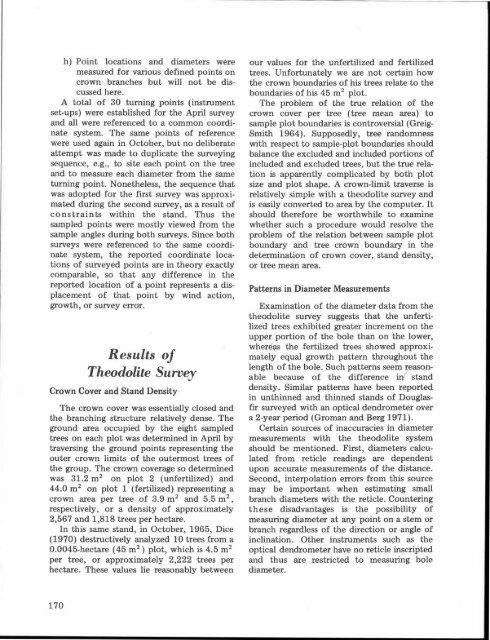PE EIE[R-Rg RESEARCH ON - HJ Andrews Experimental Forest
PE EIE[R-Rg RESEARCH ON - HJ Andrews Experimental Forest
PE EIE[R-Rg RESEARCH ON - HJ Andrews Experimental Forest
Create successful ePaper yourself
Turn your PDF publications into a flip-book with our unique Google optimized e-Paper software.
h) Point locations and diameters were<br />
measured for various defined points o n<br />
crown branches but will not be discussed<br />
here .<br />
A total of 30 turning points (instrument<br />
set-ups) were established for the April survey<br />
and all were referenced to a common coordinate<br />
system . The same points of reference<br />
were used again in October, but no deliberate<br />
attempt was made to duplicate the surveyin g<br />
sequence, e .g., to site each point on the tree<br />
and to measure each diameter from the same<br />
turning point . Nonetheless, the sequence tha t<br />
was adopted for the first survey was approximated<br />
during the second survey, as a result of<br />
constraints within the stand . Thus the<br />
sampled points were mostly viewed from th e<br />
sample angles during both surveys . Since both<br />
surveys were referenced to the same coordinate<br />
system, the reported coordinate locations<br />
of surveyed points are in theory exactl y<br />
comparable, so that any difference in th e<br />
reported location of a point represents a displacement<br />
of that point by wind action ,<br />
growth, or survey error .<br />
Results of<br />
Theodolite Survey<br />
Crown Cover and Stand Densit y<br />
The crown cover was essentially closed an d<br />
the branching structure relatively dense . The<br />
ground area occupied by the eight sample d<br />
trees on each plot was determined in April b y<br />
traversing the ground points representing th e<br />
outer crown limits of the outermost trees o f<br />
the group . The crown coverage so determine d<br />
was 31 .2 m 2 on plot 2 (unfertilized) an d<br />
44 .0 m 2 on plot 1 (fertilized) representing a<br />
crown area per tree of 3 .9 m 2 and 5 .5 m 2 ,<br />
respectively, or a density of approximatel y<br />
2,567 and 1,818 trees per hectare .<br />
In this same stand, in October, 1965, Dic e<br />
(1970) destructively analyzed 10 trees from a<br />
0.0045-hectare (45 m 2 ) plot, which is 4 .5 m 2<br />
per tree, or approximately 2,222 trees per<br />
hectare . These values lie reasonably between<br />
our values for the unfertilized and fertilized<br />
trees. Unfortunately we are not certain ho w<br />
the crown boundaries of his trees relate to th e<br />
boundaries of his 45 m 2 plot .<br />
The problem of the true relation of the<br />
crown cover per tree (tree mean area) to<br />
sample plot boundaries is controversial (Greig -<br />
Smith 1964) . Supposedly, tree randomness<br />
with respect to sample-plot boundaries should<br />
balance the excluded and included portions of<br />
included and excluded trees, but the true relation<br />
is apparently complicated by both plot<br />
size and plot shape . A crown-limit traverse is<br />
relatively simple with a theodolite survey and<br />
is easily converted to area by the computer . It<br />
should therefore be worthwhile to examine<br />
whether such a procedure would resolve th e<br />
problem of the relation between sample plo t<br />
boundary and tree crown boundary in th e<br />
determination of crown cover, stand density ,<br />
or tree mean area .<br />
Patterns in Diameter Measurement s<br />
Examination of the diameter data from th e<br />
theodolite survey suggests that the unfertilized<br />
trees exhibited greater increment on th e<br />
upper portion of the bole than on the lower ,<br />
whereas the fertilized trees showed approximately<br />
equal growth pattern throughout th e<br />
length of the bole . Such patterns seem reason -<br />
able because of the difference in / stan d<br />
density. Similar patterns have been reporte d<br />
in unthinned and thinned stands of Douglas -<br />
fir surveyed with an optical dendrometer over<br />
a 2-year period (Groman and Berg 1971) .<br />
Certain sources of inaccuracies in diameter<br />
measurements with the theodolite syste m<br />
should be mentioned . First, diameters calculated<br />
from reticle readings are dependen t<br />
upon accurate measurements of the distance .<br />
Second, interpolation errors from this source<br />
may be important when estimating smal l<br />
branch diameters with the reticle . Countering<br />
these disadvantages is the possibility of<br />
measuring diameter at any point on a stem or<br />
branch regardless of the direction or angle of<br />
inclination . Other instruments such as the<br />
optical dendrometer have no reticle inscripted<br />
and thus are restricted to measuring bole<br />
diameter.<br />
170








